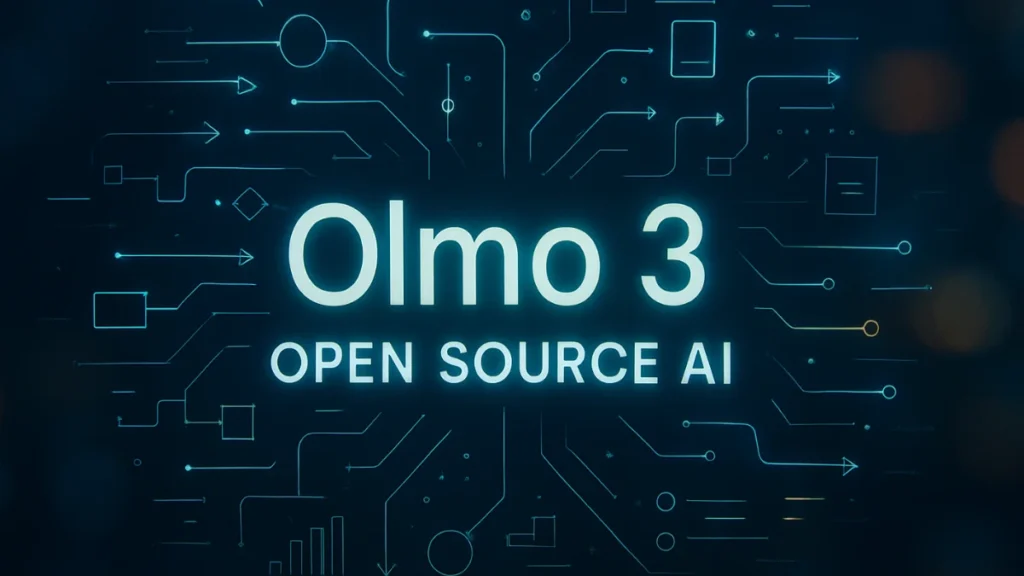When AI labs are locking down models faster than ever, the Allen Institute for AI (Ai2) just dropped a rare counter-move: Olmo 3, a fully open model family where every step of the development pipeline is exposed — not just the final weights.
It’s not just new LMs. It’s transparency as a feature.
Why this matters now
Modern AI models are built like black boxes: trained on opaque data, tuned with undisclosed methods, and shipped with zero insight into how they actually think.
Olmo 3 flips that script by publishing the full model flow—from datasets to intermediate checkpoints to RL training stages—plus a new “Think” lineage that reveals reasoning traces you can inspect in real time.
If you’ve ever wished you could actually see why a model arrives at an answer, this is that moment.
The big release: Olmo 3 in a nutshell
Ai2’s new suite arrives in four flavors:
• Olmo 3-Base (7B, 32B)
The strongest fully open base model Ai2 has released. It beats or competes with open-weights systems like Gemma 3, Qwen 2.5, Marin 32B, and Apertus 70B across reading comprehension, math, programming, and long-context tests (up to ~65K tokens).
• Olmo 3-Think (7B, 32B)
The flagship.
This is a reasoning-first model designed to expose step-by-step thinking, backtrace behavior to training data, and serve as an RL research workhorse. The 32B version competes head-to-head with Qwen 3 32B and even matches top reasoning models on benchmarks like MATH, OMEGA, HumanEvalPlus, and BigBench Hard.
• Olmo 3-Instruct (7B)
A smaller, chat-optimized model that outperforms many open-weight systems of its class on instruction following, tool use, and conversational tasks. It’s aimed at agents, copilots, and general chat experiences.
• Olmo 3-RL Zero (7B)
A fully open RL pathway with checkpoints for math, code, instruction following, and general chat — designed specifically so researchers can benchmark RL techniques with verifiable rewards.

The real breakthrough: the open model flow
Here’s the twist that sets Olmo 3 apart from every other open model release in 2025:
Ai2 didn’t just drop weights — they published the entire pipeline.
That includes:
- Dolma 3 (a new ~9.3T-token corpus)
- Dolma 3 Mix (~6T training mix with heavier math/code)
- Dolmino (mid-training mix focused on harder distributions)
- Longmino (long-context mix)
- Dolci (post-training SFT/DPO/RL mixes)
- Full checkpoints from every stage
- Tooling for decontamination, deduplication, evaluation, and data tracing
This means anyone can fork the model at any stage, inject domain-specific data, run their own SFT/DPO/RL experiments, or audit why the model behaves the way it does.
It’s an unprecedented level of transparency — bordering on academic-grade reproducibility.
Why this hits the industry now
Ai2’s move lands during a tense moment for open-source AI.
Most high-performing “open” models in 2025 ship only weights, with no data, no training code, and no reasoning transparency. Researchers call them “open-weight, closed-everything-else.”
Olmo 3 breaks that trend by:
- Publishing datasets
- Opening every training stage
- Making reasoning inspectable
- Releasing full data recipes
- Releasing RL pathways
- Enabling source-level traceability
This is the kind of radical openness many researchers have been calling for since 2023.
What’s next
Ai2 says Olmo 3 is only the beginning. More model flows, more toolkits, and more reasoning-focused releases are coming — especially around the 32B scale, which the institute calls a “sweet spot” for real research and practical deployment.
If the community picks this up, Olmo 3 could become the new default scaffold for open-source LLM development.
